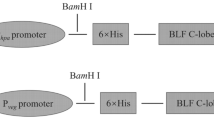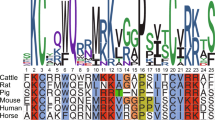Abstract
The investigation of the recombinant bovine lactoferrin-derived antimicrobial protein (rBLfA) demonstrates that the inter-lobe region of bovine lactoferrin contributes to iron binding stability and antimicrobial activity against Staphylococcus aureus. rBLfA containing N-lobe (amino acid residues 1–333) and inter-lobe region (residues 334–344) was expressed in Pichia pastoris at shaking flask and fermentor level. The recombinant intact bovine lactoferrin (rBLf) and N-lobe (rBLfN) were expressed in the same system as control. The physical–chemical parameters of rBLfA, rBLfN and rBLf including amino acid residues, molecular weight, isoelectric point, net positive charge and instability index were computed and compared. The simulated tertiary structure and the calculated surface net charge showed that rBLfA maintained original structure and exhibited a higher cationic feature than rBLf and rBLfN. The three proteins showed different iron binding stability and antimicrobial activity. rBLfA released iron in the pH range of 7.0–3.5, whereas rBLfN lost its iron over the pH range of 7.0–4.0 and iron release from rBLf occurred in the pH range of 5.5–3.0. However, the minimum inhibition concentration of rBLfA against S. aureus ATCC25923 was 6.5 μmol/L, compared with 12.5 and 25 μmol/L that of rBLfN and rBLf, respectively. These results revealed that S. aureus was more sensitive to rBLfA than rBLfN and rBLf. It appeared that the strong cationic character of inter-lobe region related positively to the higher anti-S. aureus activity.





Similar content being viewed by others
References
Baker EN, Baker HM (2009) A structural framework for understanding the multifunctional character of lactoferrin. Biochimie 91(1):3–10
Baker EN, Anderson BF, Baker HM et al (1994) Three-dimensional structure of lactoferrin in various functional states. Adv Exp Med Biol 357:1–12
Baker EN, Baker HM, Kidd RD (2002) Lactoferrin and transferrin: functional variations on a common structural framework. Biochem Cell Biol 80(1):27–34
Bellamy W, Takase M, Yamauchi K et al (1992) Identification of the bactericidal domain of lactoferrin. Biochim Biophys Acta 1121(1–2):130–136
Chen HL, Lai YW, Yen CC et al (2004) Production of recombinant porcine lactoferrin exhibiting antibacterial activity in methylotrophic yeast, Pichia pastoris. J Mol Microbiol Biotechnol 8(3):141–149
Chen GH, Yin LJ, Chiang IH et al (2007) Expression and purification of goat lactoferrin from Pichia pastoris expression system. J Food Sci 72(2):67–71
Choi BK, Actor JK, Rios S et al (2008) Recombinant human lactoferrin expressed in glycoengineered Pichia pastoris: effect of terminal N-acetylneuraminic acid on in vitro secondary humoral immune response. Glycoconj J 25(6):581–593
Cregg JM (ed) (2007) Pichia protocols. Humana Press, Totowa
Day CL, Stowell KM, Baker EN et al (1992) Studies of the N-terminal half of human lactoferrin produced from the cloned cDNA demonstrate that interlobe interactions modulate iron release. J Biol Chem 267(20):13857–13862
Dong ZY, Zhang YZ (2006) Molecular cloning and expression of yak (Bos grunniens) lactoferrin cDNA in Pichia pastoris. Biotechnol Lett 28(16):1285–1292
Haversen L, Kondori N, Baltzer L et al (2010) Structure-microbicidal activity relationship of synthetic fragments derived from the antibacterial alpha-helix of human lactoferrin. Antimicrob Agents Chemother 54(1):418–425
Kiefer F, Arnold K, Kunzli M et al (2009) The Swiss-model repository and associated resources. Nucleic Acids Res 37(Database issue):D387–D392
Legrand D, Mazurier J, Colavizza D et al (1990) Properties of the iron-binding site of the N-terminal lobe of human and bovine lactotransferrins. Importance of the glycan moiety and of the non-covalent interactions between the N- and C-terminal lobes in the stability of the iron-binding site. Biochem J 266(2):575–581
Lonnerdal B (2009) Nutritional roles of lactoferrin. Curr Opin Clin Nutr Metab Care 12(3):293–297
Metz-Boutigue MH, Jolles J, Mazurier J et al (1984) Human lactotransferrin: amino acid sequence and structural comparisons with other transferrins. Eur J Biochem 145(3):659–676
Moore SA, Anderson BF, Groom CR et al (1997) Three-dimensional structure of diferric bovine lactoferrin at 2.8 a resolution. J Mol Biol 274(2):222–236
Mukhtar TA, Koteva KP, Hughes DW et al (2001) Vgb from Staphylococcus aureus inactivates streptogramin b antibiotics by an elimination mechanism not hydrolysis. Biochemistry 40(30):8877–8886
Nakamura I, Watanabe A, Tsunemitsu H et al (2001) Production of recombinant bovine lactoferrin N-lobe in insect cells and its antimicrobial activity. Protein Expr Purif 21(3):424–431
Paramasivam M, Saravanan K, Uma K et al (2002) Expression, purification, and characterization of equine lactoferrin in Pichia pastoris. Protein Expr Purif 26(1):28–34
Peterson NA, Anderson BF, Jameson GB et al (2000) Crystal structure and iron-binding properties of the R210 K mutant of the N-lobe of human lactoferrin: Implications for iron release from transferrins. Biochemistry 39(22):6625–6633
Sandrini SM, Shergill R, Woodward J et al (2010) Elucidation of the mechanism by which catecholamine stress hormones liberate iron from the innate immune defense proteins transferrin and lactoferrin. J Bacteriol 192(2):587–594
Sharma S, Jasti J, Kumar J et al (2003) Crystal structure of a proteolytically generated functional monoferric C-lobe of bovine lactoferrin at 1.9A resolution. J Mol Biol 331(2):485–496
Tanaka T, Nakamura I, Lee NY et al (2003) Expression of bovine lactoferrin and lactoferrin N-lobe by recombinant baculovirus and its antimicrobial activity against Prototheca zopfii. Biochem Cell Biol 81(5):349–354
Valenti P, Antonini G (2005) Lactoferrin: an important host defence against microbial and viral attack. Cell Mol Life Sci 62(22):2576–2587
van Berkel PH, Welling MM, Geerts M et al (2002) Large scale production of recombinant human lactoferrin in the milk of transgenic cows. Nat Biotechnol 20(5):484–487
Wally J, Buchanan SK (2007) A structural comparison of human serum transferrin and human lactoferrin. Biometals 20(3–4):249–262
Wang SH, Yang TS, Lin SM et al (2002) Expression, characterization, and purification of recombinant porcine lactoferrin in Pichia pastoris. Protein Expr Purif 25(1):41–49
Wilkins MR, Gasteiger E, Bairoch A et al (1999) Protein identification and analysis tools in the Expasy server. Methods Mol Biol 112:531–552
Acknowledgments
This study is supported by National Natural Science Foundation of China (No. 30972125, 30771574, 30810303084), and Beijing Natural Science Foundation (No. 5062031, 5093030).
Author information
Authors and Affiliations
Corresponding author
Rights and permissions
About this article
Cite this article
Bai, X., Teng, D., Tian, Z. et al. Contribution of bovine lactoferrin inter-lobe region to iron binding stability and antimicrobial activity against Staphylococcus aureus . Biometals 23, 431–439 (2010). https://doi.org/10.1007/s10534-010-9300-x
Received:
Accepted:
Published:
Issue Date:
DOI: https://doi.org/10.1007/s10534-010-9300-x




